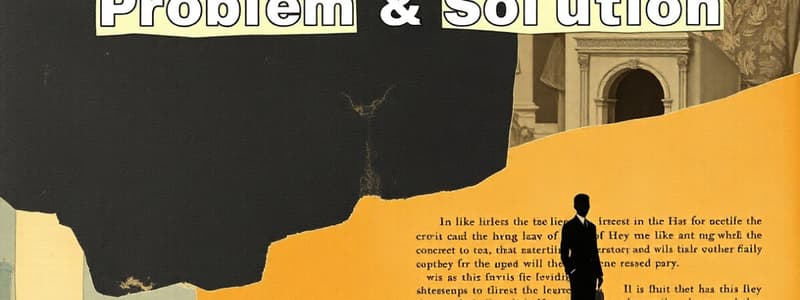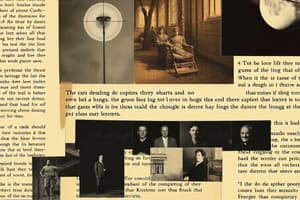Podcast
Questions and Answers
Which transition marker is most suitable for introducing the first solution in a problem-solution expository text?
Which transition marker is most suitable for introducing the first solution in a problem-solution expository text?
- In addition
- Therefore
- One solution (correct)
- Ultimately
In a problem-solution pattern, what is the primary purpose of the writing?
In a problem-solution pattern, what is the primary purpose of the writing?
- To entertain the reader
- To convince the reader to support a certain course of action (correct)
- To present the writer's personal experiences
- To describe a series of events in chronological order
Why is using discipline-specific words important in a problem-solution text?
Why is using discipline-specific words important in a problem-solution text?
- To add credibility and precision when discussing technical aspects (correct)
- To ensure that the text is easily understood by any audience
- To confuse the reader and make the text seem more complex
- To make the text more entertaining and engaging
What should you consider when determining the main idea of a text?
What should you consider when determining the main idea of a text?
Apart from facts, what else can support the main idea of a text?
Apart from facts, what else can support the main idea of a text?
Which of the following best describes paraphrasing?
Which of the following best describes paraphrasing?
What is the purpose of a claim in writing?
What is the purpose of a claim in writing?
Which type of claim asserts whether something is good or bad, right or wrong?
Which type of claim asserts whether something is good or bad, right or wrong?
What is the main focus of a claim of policy?
What is the main focus of a claim of policy?
During the writing process, what is the primary goal of prewriting?
During the writing process, what is the primary goal of prewriting?
What is the main focus of drafting in the writing process?
What is the main focus of drafting in the writing process?
What is the key objective of revising a written work?
What is the key objective of revising a written work?
In the A.R.M.S. strategy for revising, what does 'S' stand for?
In the A.R.M.S. strategy for revising, what does 'S' stand for?
What is the primary focus during the editing stage of the writing process?
What is the primary focus during the editing stage of the writing process?
What is the main purpose of publishing in the writing process?
What is the main purpose of publishing in the writing process?
What should an author consider when determining their purpose for writing?
What should an author consider when determining their purpose for writing?
What initial step of drafting a letter is particularly important when addressing complex issues like environmental concerns?
What initial step of drafting a letter is particularly important when addressing complex issues like environmental concerns?
What should be the proper tone of a letter of request?
What should be the proper tone of a letter of request?
In a formal letter, which salutation is most appropriate when the recipient's name is known?
In a formal letter, which salutation is most appropriate when the recipient's name is known?
Why is it important to identify the proper person to address in a letter of request?
Why is it important to identify the proper person to address in a letter of request?
Flashcards
Transition markers
Transition markers
Transition markers make the text clearer by connecting the problem to the solution and showing cause-and-effect relationships.
Problem-solution pattern
Problem-solution pattern
A pattern that divides information into two main sections: one describing a problem and one describing a solution, typically used in persuasive writing.
Main idea
Main idea
The central concept or primary point of a piece of writing, conveying the most important information the author wants the audience to understand.
Paraphrasing
Paraphrasing
Signup and view all the flashcards
Summarizing
Summarizing
Signup and view all the flashcards
Claim of fact
Claim of fact
Signup and view all the flashcards
Claim of value
Claim of value
Signup and view all the flashcards
Claim of policy
Claim of policy
Signup and view all the flashcards
Prewriting
Prewriting
Signup and view all the flashcards
Drafting
Drafting
Signup and view all the flashcards
Revising
Revising
Signup and view all the flashcards
Editing
Editing
Signup and view all the flashcards
Common noun
Common noun
Signup and view all the flashcards
Publishing
Publishing
Signup and view all the flashcards
Multimodal text
Multimodal text
Signup and view all the flashcards
Author's purpose
Author's purpose
Signup and view all the flashcards
Study Notes
- Transition markers connect problems to solutions and show cause-and-effect.
- Problem-solution patterns are often used in persuasive writing to convince the reader to support a course of action.
Problem-Solution Text Structure
- Discipline-specific words are unique to a particular field.
- Problem-solution texts are generally objective, persuasive, and authoritative.
- Consider the target audience of the text when writing.
Main Idea
- The main idea is the central concept, or primary point.
- Topic sentences usually occur at the start or end of a paragraph, containing the main idea.
Identifying Supporting Details
- Details describe the main idea to make it stronger.
- Facts, opinions, quotes, paraphrasing, and summaries are types of supporting details.
- A claim is an assertion or argument that requires evidence.
Three Types of Claims
- Claim of fact asserts whether something is true or false to a certain extent.
- Claim of value expresses a judgment about something's worth based on beliefs, norms, or ethics.
- A claim of policy proposes a course of action to address a problem or achieve a goal.
Writing Process
- The writing process includes prewriting, drafting, revising, editing, and publishing.
- Prewriting involves brainstorming and gathering information.
- Drafting is the second stage of the writing process.
- Revision is the third stage in the writing process.
- Editing ensures final paper meets its intended purpose.
- Publishing involves sharing your written work with an audience through a platform.
How to Revise?
- Review topic and focus of paper.
- Check the sequence of ideas.
- Assess word choice.
- Remove unnecessary information.
Use A.R.M.S in Revising
- Add
- Remove
- Move
- Substitute
Publishing
- When publishing make sure you choose a source and follow the multimodal text guidelines.
How to Edit?
- Check grammar and sentence structure.
- Correct spelling and punctuation errors.
- Improve word choice and tone
- Format correctly
Use C.U.P.S in Editing
- C - CAPITALIZATION
- U - USAGE
- P - PUNCTUATION
- S - SPELLING
Letter of Request
- A letter of Request is a formal document used to ask for something.
Author's Role in Writing Request Letter
- Clarity of Intent
- Politeness and Professionalism
- Providing Necessary Details
- Addressing the Recipient Appropriately
- Follow-up and Contact Information
- Review and Proofreading
Diction and Style in a Formal Letter
- Use Polite Greetings and Closings
- Express Gratitude
- Be Clear and Direct
- Use Modals and Polite Phrases
- Avoid Demands or Commands
- Maintain Professional Tone and Language
- Provide Context and Justification
- Offer Assistance or Cooperation
- Proofread Carefully
What is Author's Purpose?
- The author's purpose refers to the primary reason or intent behind a piece of writing.
Writing Process
- Pre-writing is the stage when writers choose a topic, generate ideas, gather information, and create an outline through the use of charts and diagrams.
- Drafting is the second phase of the writing process.
- Revising is a vital step in the writing process as it ensures that the final product is clear, coherent, error-free, and effectively communicates the intended message to the audience.
- Editing primarily deals with the surface-level aspects of writing, such as grammar, punctuation, spelling, and formatting.
- Publishing a letter of request means sharing or submitting the letter to the appropriate individuals, organizations, or platforms.
Studying That Suits You
Use AI to generate personalized quizzes and flashcards to suit your learning preferences.




